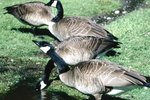
There are two different species of blue heron: the great blue heron (Ardea herodias) and the little blue heron (Egretta caerulea). Although the males and females of both species may look similar at first glance, there are some subtle differences in both their appearance and behavior by which you can tell them apart.
Great Blue Heron Appearance
If you spot any great blue herons, you may need to look closely to distinguish the males from the females. Males are slightly larger, usually coming closer to the high end of their length range, around 54 inches, whereas females may be nearer the low end, at roughly 38 inches long. Males also have larger beaks than females and may have some puffy plumage on the backs of their heads.
Great Blue Heron Mating and Nesting Behavior
If you observe great blue herons during their mating and nesting season, you may spot some behaviors that will help differentiate the sexes. While males and females both take part in an elaborate mating ritual, there are some differences in their roles. Males make their way to the nesting site first and gather materials with which to make a nest. They then present these materials to the female, who alone weaves them into the form of a nest.
Little Blue Heron Appearance
Unfortunately, it may be impossible to tell male and female little blue herons apart just from looking at them, as the two sexes look almost identical. However, you can easily tell the juveniles from the adults, as they have very different coloration. Where adults are dark blue all over, with a maroon head and neck, juveniles have completely white plumage.
Little Blue Heron Mating and Nesting Behavior
It's only during their breeding season that you'll be able to tell the male little blue heron from the female. The male arrives at the breeding ground first and picks out a nesting site, close to a forked tree. He courts females by stretching his neck out and pointing his bill up, then crouching and snapping his bill, before swaying his neck and vocalizing. If the female responds, she will approach him and they will twine their necks together and groom one another. The male then gathers nesting materials while the female builds the nest.
References
Photo Credits
-
Tom Brakefield/Stockbyte/Getty Images



